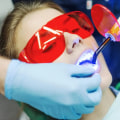Dental laser cleaning is a minimally invasive procedure that can be used to treat periodontal disease. It involves using a laser to access and remove inflamed gingival tissue from around the root of the tooth. This procedure is often preferred over traditional surgery due to its shorter recovery time and minimal bleeding and swelling. The surgery area will have small blood clots, so it's important to gently brush these areas.
You can resume your regular diet and brush your teeth two weeks after surgery. Your gums will fully heal in two to four weeks. McCormick will schedule a follow-up appointment to check the progress of healing and ensure that the tissue in the treated area looks healthy and free of any infection. Tooth sensitivity can take a few months to go away and, in some cases, it can take up to a year for the gums and surrounding teeth to heal completely. You will be scheduled for regular follow-ups to monitor the progress of the treated area and address any ongoing issues.
Dental desensitizers are available if needed. As for “pocket pain,” laser treatment may cost more upfront, but since it requires fewer visits to the dentist and is covered by most dental insurance, it often costs little or nothing more than other major periodontal treatment methods. After the first 24 hours of healing are complete, brush and floss adjacent teeth normally and gently clean the area where the laser was used with a swab dipped in Listerine. In periodontal laser therapy, the hygienist uses a laser to access and remove inflamed gingival tissue from around the root of the tooth. Since laser surgery doesn't use a scalpel and then no dental sutures (stitches) are needed, bleeding and swelling are minimal and the healing process is much faster. After laser gum therapy, the body will immediately begin the healing process, and using a laser instead of traditional surgical instruments also helps stimulate bone and gum growth. Instead of removing the gums from 2 to 15 mm, depending on the severity of the infection, to access deep periodontal pockets, the laser can reach and clean these areas without causing significant gum line recession. The recovery time for dental laser cleaning is relatively short compared to traditional surgery.
However, it's important to follow your dentist's instructions carefully during this time in order to ensure proper healing. Brush gently around the treated area, avoid hard or crunchy foods, and use dental desensitizers if needed. Regular follow-up appointments are also important in order to monitor your progress.







